Located roughly seven miles from each other along Ghana’s Gulf of Guinea coast are two of the country’s most infamous locations, Elmina and Cape Coast.
Both instrumental in the Transatlantic Slave Trade, Elmina and Cape Coast serve as living historical museum that have preserved the region’s brutal and horrifying past.
It is a history that went on to change the history of much of the world. Echoes of the region’s haunting past are still felt around the world to this day.
It should come as no surprise many of the top things to do in Elmina and Cape Coast, Ghana serve as grim reminders of that tragic time in human history.

While the specter of slavery hangs over the area, there are other things to dive into. From its bustling markets to its beautiful Asafo shrines and the Kakum National Park within walking distance, the area is rich in attractions sure to please any curious traveler.
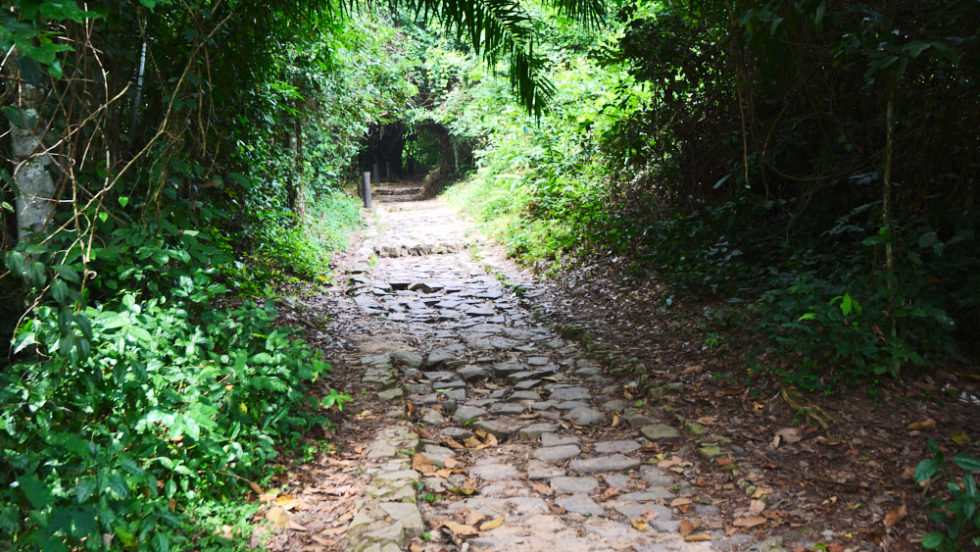
The region is inhabited by the Fante people, who are well-known for their rich cuisine. The diet consists of proteins including fish and other meat, as well as soups, stews, shito, and starchy dishes like Fante kenkey and fufu.

In my career as a world traveler, I have explored over 1,200 cities, town, and villages across 84 countries and six continents. But few places have had the impact on me that Elmina and Cape Coast had.
As a student of history, I was well aware of the basic facts about the region’s past. But it’s a whole other thing to visit the locations where human lives were cruelly devalued and discarded and where unimaginable horrors were inflicted on innocent people.

It’s hard to not get emotional as you explore the shadowy tunnels and dank chambers of the area’s slave castles.
More than once, I found myself getting choked up as my guides delved into the horrors of the castle’s past. While it’s not easy to be there, learning the history is incredibly important.
I have to thank my incredible guides at Jolinaiko Eco Tours for sharing their wealth of knowledge with me, not only in Elmina and Cape Coast, but throughout my entire Ghana trip.
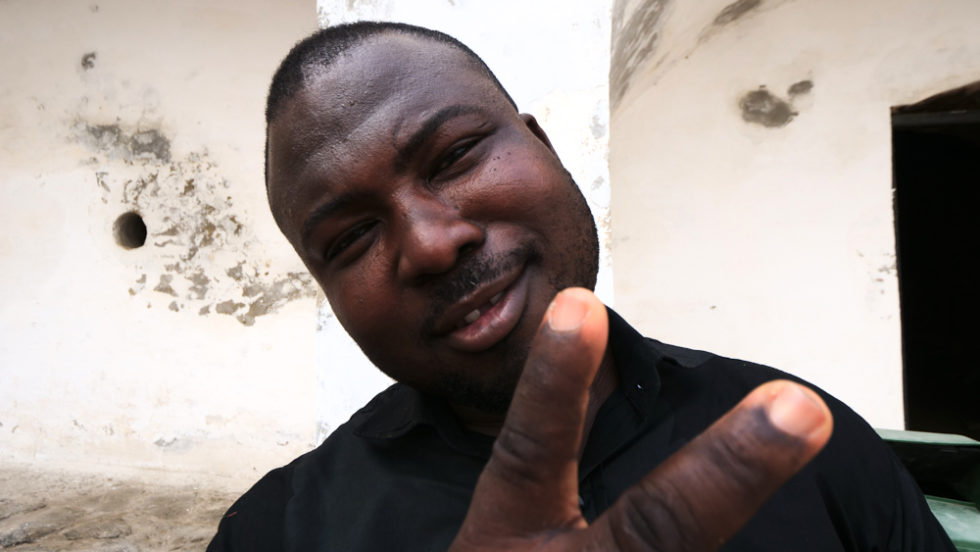
But I also found the cities quite beautiful and inspiring. The people I met were extremely kind and friendly, and it felt great to be embraced by them.
Sharing in their food and culture adventure was definitely a highlight, and it makes me excited to share my experiences with you here. These are the top 10 Elmina things you must do in Elmina and Cape Coast, Ghana!

Although they may look fairly close on a map, the capital city of Accra and Cape Coast are roughly a four-hour drive apart.
I made a few stops along the way to eat and check out a unique attraction, so it took me six hours. The road runs parallel to the coast, and cuts through lots of empty land with lush greenery.
The vegetation and landscapes reminded me of those I saw during my road trip through Malawi back in 2013. But the land isn’t entirely empty. There are a couple of notable spots you’ll want to hit up on your way to Cape Coast!

Along the route from Accra to Cape Coast is an unassuming building that serves as a coffin workshop! But they don’t design and sell ordinary coffins here. These are unique coffins that are made to symbolize a person’s a deep passion or occupation.

A quick scan of the workshop will tell you everything you need to know about this place. Their whimsical, unconventional coffins are built to look like just about anything you wish. That includes houses, crocodiles, crabs, cobras, chili peppers, and even boats!

Touring the workshop is a treat. From ornate caskets made for royalty to those resembling giant cell phones, it’s wild! Each coffin is more unconventional than the last.
In case you want their services, they have an album of casket photos you can look through to get an idea of what you may want.

I’m often surprised and blown away by the things I see while traveling, and these coffins certainly had me at a loss for words! Even though it’s located well outside of the cities, I couldn’t not include it on my list of the best things to do in Elmina and Cape Coast, Ghana!
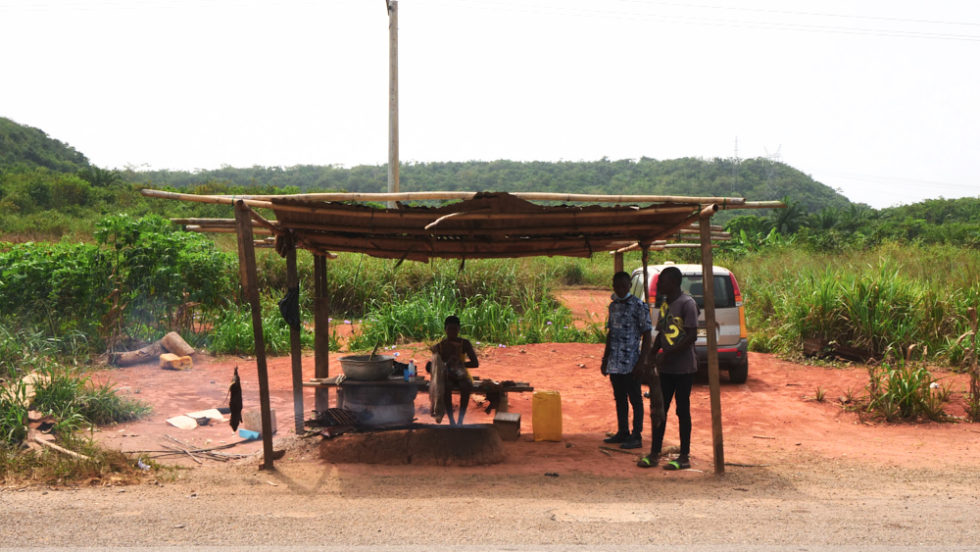
When traveling, it’s always important to keep an open mind. People from other cultures often do, drink, and eat things that may seem shocking to people from other cultures.
With our own cultural norms ingrained in us, it’s easy to pass judgment when we see something outside that norm. But to me, experiencing those things is one of the joys of traveling the world.
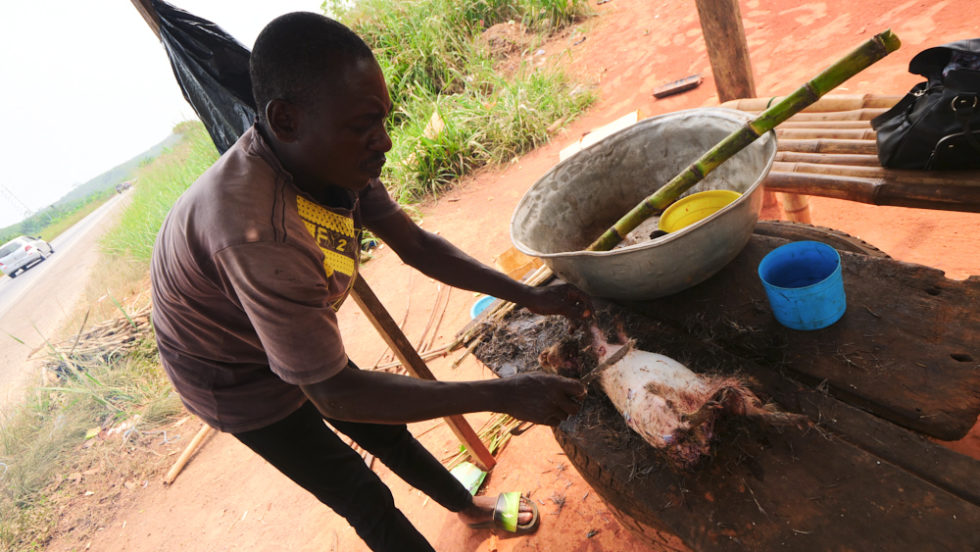
Along the route to Cape Coast, you’ll come across little open-air stalls on the side of the road. If you stop by, you’ll likely meet locals skinning and roasting grasscutters.
Grasscutters are a type of large rodent indigenous to the area. They’re a source of protein around the country and their meat can be found in stews and other local recipes.

The vendors prefer to sell the grasscutters when they’re freshly killed. But if they can’t sell them fresh, they skin and gut them, use wooden stakes to spread out their skin, and smoke them over a fire. The grasscutters turn a rich, reddish-brown color and look like massive guinea pigs!

If you’re brave enough, buy one and try a bit of the meat. Or, if you prefer, try the meat in a stew elsewhere.
Either way, it’s a wild and unique food experience you can only get in this part of the world. No trip to Elmina and Cape Coast, Ghana is complete without tasting some!
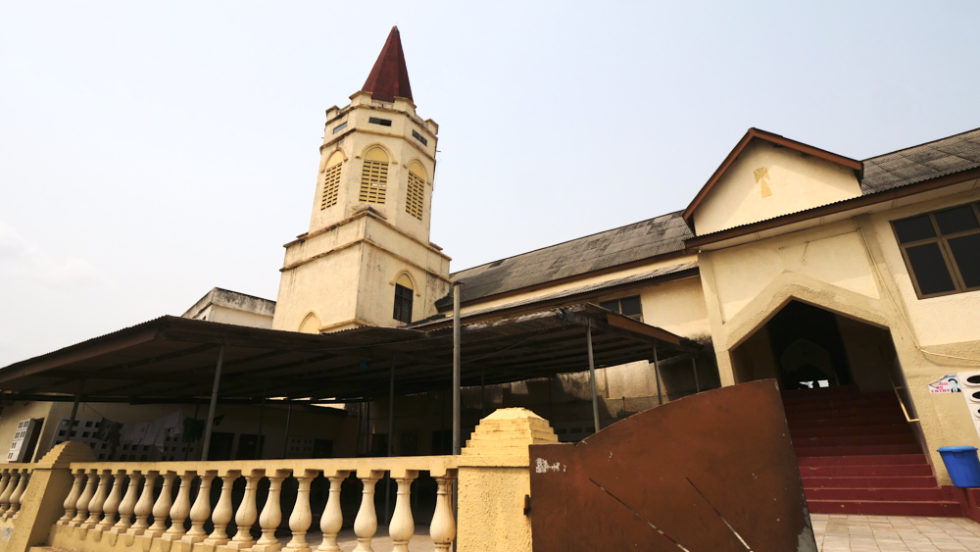
Cape Coast is one of Ghana’s most historic cities. It is part of a massive UNESCO World Heritage Site called Forts and Castles, Volta, Greater Accra, Central and Western Regions.
The site extends roughly 500 kilometers along the Gulf of Guinea Coast and includes forts and castles such as St George’s Castle in Cape Coast, Fort St jago and more in Elmina, and Accra in Ghana.
During my visit, I was also visiting St george’s Castle to learn about its history. As of 2010, the city was home to just under 170,000 people, who speak an Akan dialect called Fante.

The city was first founded by the Oguaa people. They called it Oguaa or Kotokuraba, which translates to “River of Crabs” or “Village of Crabs.”
Portuguese sailors named the area Cabo Corso, or Short Cape, after they sailed past the area in 1471.
They soon built a trading fort in Oguaa, and the Swedes then built the lodge that later became Cape-Coast Castle in 1650.
The growing town was taken over by the Dutch in 1650 and then the British in 1664. You would also find a Dutch cemetery nearby to further justify their presence.

Numerous trading lodges, castles, and forts were built along Ghana’s coast. The commodities included gold, honey, and most unfortunately, enslaved Africans.
Most of the slaves were held at Cape-Coast Castle before being loaded onto ships for the harrowing and horrific journey to the Americas and the Caribbean.

Today, Cape Coast is a busy fishing port and the capital of the Central Region of Ghana as well as the Cape Coast Metropolitan District.

The first thing I suggest you do upon arriving in Cape Coast and Elmina, Ghana is getting something to eat. I recommend heading to a popular local spot called Emma Locals Chop Bar.
You’ll find chop bars, or “places to eat,” throughout Ghana. They’re the perfect place to mingle with the locals and try some local fare.
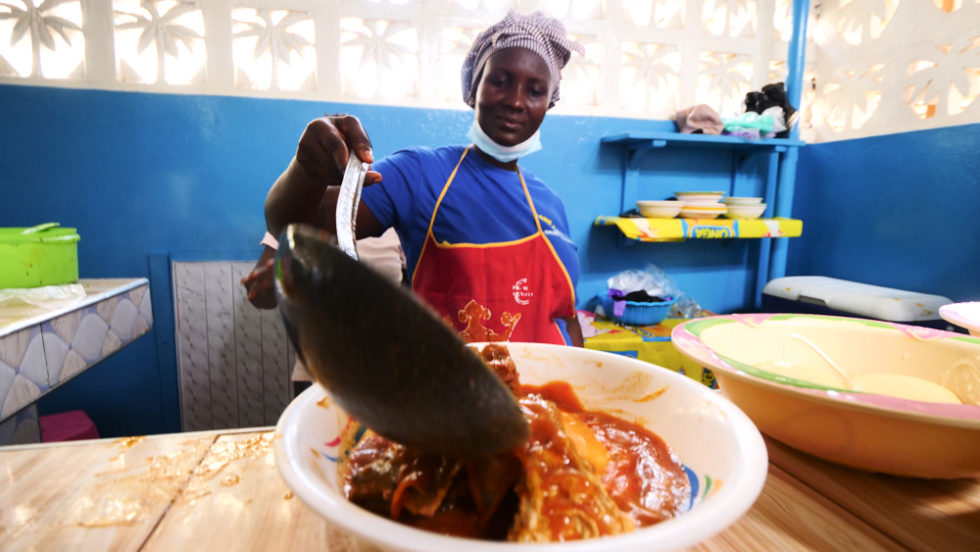
I went with a local staple called fufu, which is a sticky, starchy dough ball made from boiled and pounded plantains and cassava flour. They served it to me along with a vibrant red soup that contained ginger, goat meat, and fresh tuna.
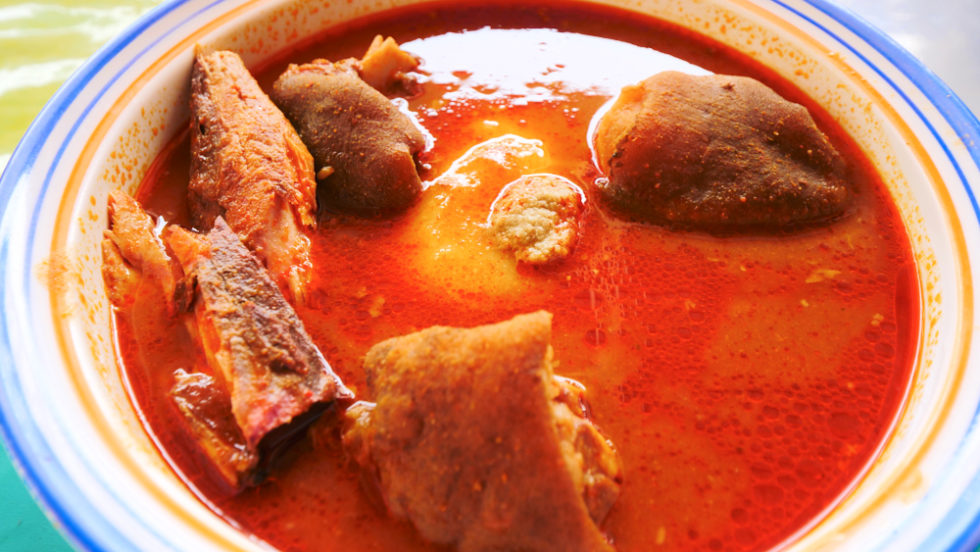
Fufu is one of several doughy and starchy West African dishes meant to fill you up. It certainly does that, but it also pairs incredibly well with the soup and meat.
The texture combination is fantastic! Best of all, they don’t skimp on the servings, so you’ll get lots of chunks of hearty goat meat and some bony but delicious tuna.

One thing you may not be used to is eating soup or stew with your hands. But it’s customary in Ghana, so wash them well and dive on in! Be careful of any small bones and be sure to suck the marrow out of the goat bones for added flavor. Best of all, it only costs 86 Cedi, or about $14.31 for a party of four!
Emma Locals
4P9J+QV3
Cape Coast, Ghana
+233 24 477 9565

Just a few blocks from Cape-Coast Castle, in the middle of town, is an expansive market area. There, you’ll find a number of vendors selling everything from freshly caught fish to rice to squid to egg stew.
You can also buy clothing and other items. It’s a great spot in the Elmina and Cape Coast, Ghana area to immerse yourself in the local culture!

Speaking of the locals, as Cape Coast is very much a fishing town, one of the most important sites you can visit in town is the fishing village.
This area is a bustling, chaotic area of town right on the beach, just a few hundred yards down the shore from Cape-Coast Castle.

There, you can see hundreds of colorful wooden fishing boats sitting on the sand. The fishermen go out and come back in all day long with their catch. Just keep in mind that the people here aren’t a big fan of being filmed or having photos taken of them.

Remember to always ask permission first and respect their wishes if they say no. Some of the best views of the fishing village come from the castle itself, so I recommend going there to take photos of the area.

Of course, Cape Coast Castle is much more than a place to take photos. Its heavy, oppressive history as one of roughly 40 slave castles along the Ghanaian coast is front and center the moment you arrive.
The castle, which began as a Portuguese trading post in 1555, later evolved into a timber fort constructed by the Swedish Africa Company in 1653. The present-day castle was built by the British in the 18th century.

Cape Coast Castle began as an instrumental location for timber and gold trading, but later became the castle that most enslaved Africans passed through on their way to the New World.
After slaves became the most valuable commodity to pass through Cape Coast, the Europeans built underground dungeons .
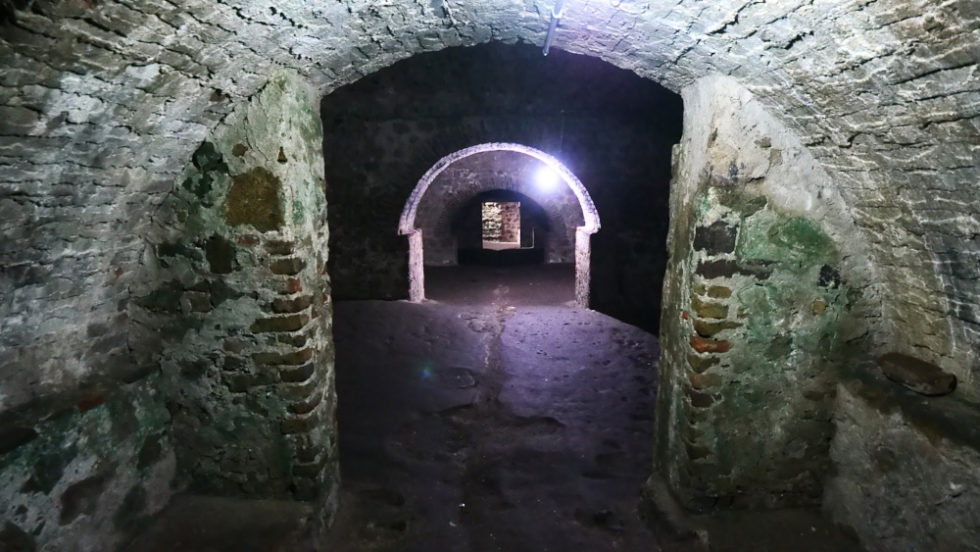
With separate dungeons for men and women, they could hold up to a thousand people at a time. On average, slaves were held there for six weeks, but sometimes were imprisoned there for up to 12 weeks. There were no restrooms, so during that time, the slaves were forced to live in their own filth.
As time wore on, the floors became caked with urine, feces, menstrual blood, and vomit, and sickness and diseases quickly spread.

They became so covered in filth that even today, the bricks on the floor aren’t visible and an unpleasant odor emanates from the floor and walls. These unimaginable living conditions are in stark contrast to the living quarters of the European officers, who lived in relative opulence.

Occasionally, the officers would select a female slave to sleep with. The woman would be taken to the ocean and bathed before returning to the dungeon afterward.
Some women became their concubines and bore the officers’ children. Other women were held in tiny chambers, waiting to be raped. They were only released once they decided to go through with it.

Most ironically, there was a church standing just above the male dungeons. Outside it is a plaque commemorating the visit of President Barack Obama and First Lady Michelle Obama on July 11, 2009.

Visiting Cape Coast Castle was a sobering experience. My heart was heavy as my guide Isaac and I toured the castle, and I learned the specifics of the atrocities committed there. Of the many horrible things I learned, perhaps the saddest was the story of the Door of No Return.

The slaves, chained together, would be marched, single-file, through the door to awaiting ships. It was the last time they were in their country, and oftentimes, the last time they saw their loved ones, before heading across the Atlantic.

As a student of history, I believe it is our obligation to learn about the good, bad, and ugly parts of our history. We need to be aware of our past so we never repeat the mistakes of those who came before us. Visiting Cape Coast Castle is not a fun experience, but it’s necessary when you visiting Elmina and Cape Coast, Ghana.
Cape Coast Castle
Victoria Road
Cape Coast, Ghana
+233 57 710 1707

Also known as Edina, the coastal city of Elmina holds the distinction of being the first European settlement in West Africa. The city was known by its historical name, Anomansah, before the Portuguese arrived in the 15th century and won control of the Guinea trade. The city began to grow following the construction of São Jorge da Mina Castle, a.k.a. Elmina Castle, in 1482.

Early on, the main commodity exploited by the Portuguese was gold. But before long, enslaved Africans became the main export, with upwards of 12,000 men and women funneled through the castle between 1500 and 1535.

Elmina’s location was important, as it served as a popular port where ships heading south around the Cape of Good Hope could get more provisions. Today, fishing is the main industry in Elmina, though tourism and salt production are also vital.

As the largest fishing town in Ghana, Elmina’s coastline becomes an electric and frenetic location soon after sunrise. From the brightly painted Old Bridge, you can get a spectacular view of the lagoon, fishing boats, fishermen, and the sprawling Elmina Fish Market below. To show me the ins and outs of the market, I hired a local guide named Michael from Torchlight Tours.

Here, the unmistakable briny smell of fish and ocean water blends with the aroma of cooking banku. On every day except Tuesday, you’ll find local fishermen come in with their catch early in the morning after being at sea overnight.

In the market, the fishmongers enthusiastically sell the fishermen’s catch, which ranges from a wide variety of fish, shrimp, squid, and even the occasional shark! Seeing all the different types of seafood is quite the spectacle! Just remember to ask the fishermen and fishmongers permission before taking photos or video. Like in Accra and Cape Coast, locals here are often wary of cameras. Some may consent to be photographed and filmed for a small fee.

Elsewhere on site is the carpentry area of the market, where you can see fishing boats being built. You’ll also find fishermen mending their nets and de-scaling their fish.

You can also see the fishmongers smoke and preserve fish on large screens stacked over a fire. The smoked fish are quite salty and full of flavor!
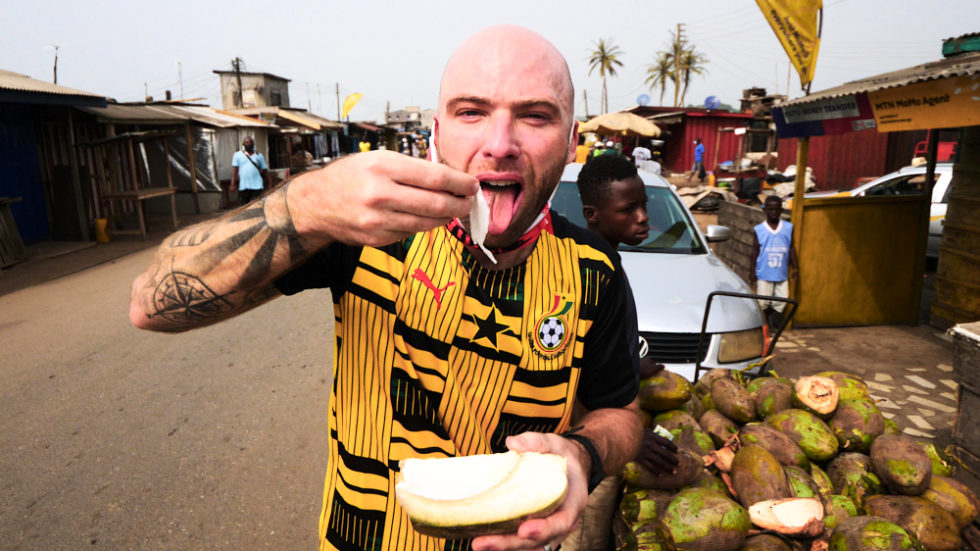
After trying the salty smoked fish, you may want something refreshing as a palate cleanser. Luckily, the busy streets are home to coconut vendors. Drinking the water inside and downing the cool, fresh coconut meat is a great way to stay hydrated in the Ghanaian heat!

If you want something a bit more substantial than smoked fish or coconut, I suggest buying some waakye. Arguably one of the most popular dishes in Ghana, waakye consists of rice, beans, and pasta. It’s served with fish stew, cassava flour, and a spicy sauce called shito.
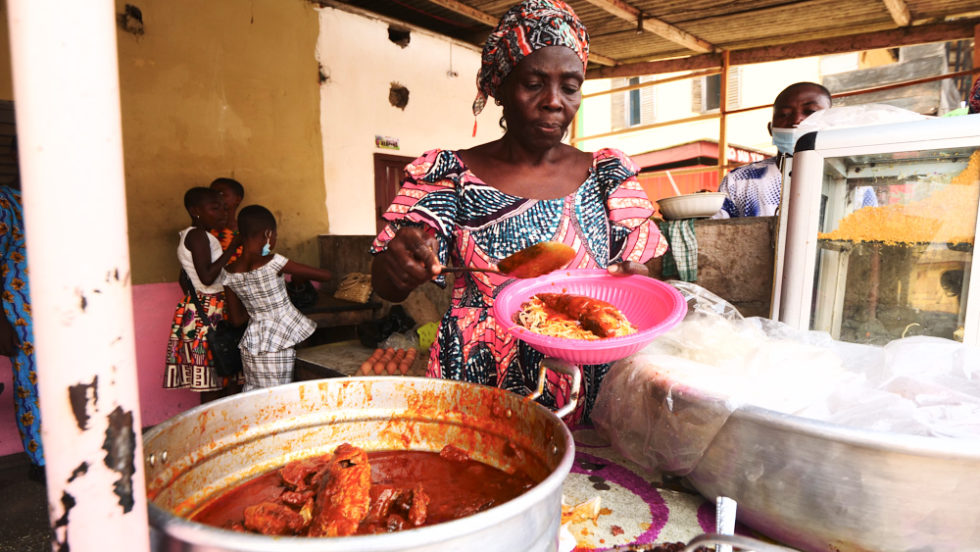
Everything about waakye is outstanding. It’s truly authentic to the locals and the contrasts of the different textures is unreal. The hearty beans, combined with the filling rice and pasta and meaty fish would be great by itself. But then you add in the crunchy cassava flour and the fiery flavor of the shito and you have an incredible, mouthwatering dish!

Different variations of waakye can be found throughout the country. It’s the dish I probably ate the most during my trip to Ghana and is one of my favorites! If you’re in Elmina and Cape Coast, or any other region of Ghana, seek it out and try it for yourself!
Elmina Fish Market
34 Benya St.
Elmina, Ghana

Elmina Castle holds a number of distinctions. It’s the first European trading post built along the Gulf of Guinea and the oldest European building south of the Sahara Desert. Elmina castle is also one of the most infamous and instrumental locations along the Atlantic slave trade route.
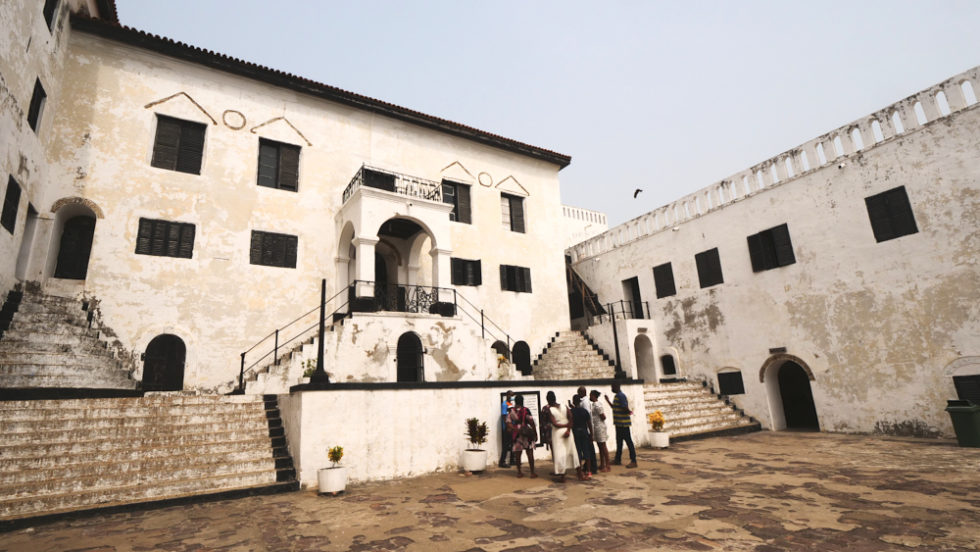
Established by the Portuguese in 1482, the Dutch later seized Castelo de São Jorge da Mina in 1637. The British then took it in 1872. It began as a trading post nicknamed A Mina, or “the Mine,” because of the gold found in the area.

But the castle would later become a depot of sorts, where the Europeans would hold enslaved Africans from various West African kingdoms. After the beginning of the slave trade began, they converted the storerooms on the ground floor into dungeons.

Elmina Castle boasts high defensive walls and a moat. Off the main courtyard, you’ll find a cell in Elmina castle that held freedom fighters and anyone who resisted enslavement. There are also six dungeons in total. Three held men and the other three, women.

I visited one of the female dungeons. Like the ones I visited in Cape Coast Castle, there’s a dark, heavy feeling you just can’t shake while you’re there. This particular dungeon held about 400 women. The dungeon’s walls were painted in 1979 when the castle became a UNESCO Heritage Site. In normal, non-pandemic times, visitors can sleep in the dungeons to get the tiniest taste of what the experience was like.

Like This Castle, Elmina Castle also contains a Room of No Return and a Gate of No Return. Between five and ten men, chained to one another, inched sideways through a narrow opening to the awaiting ships on the other side.

Also similarly to this Castle, the officers’ quarters were far more comfortable than the dungeons below. They offer beautiful views of the ocean, the cannons on the ramparts, the fish market, and the entire town. It’s a stunning view from a sad, soul-crushing location. But as awful as it is, like Cape Coast Castle, Elmina Castle is a must-visit when visiting Ghana.
Elmina Castle
Elmina, Ghana
+233 20 179 6793
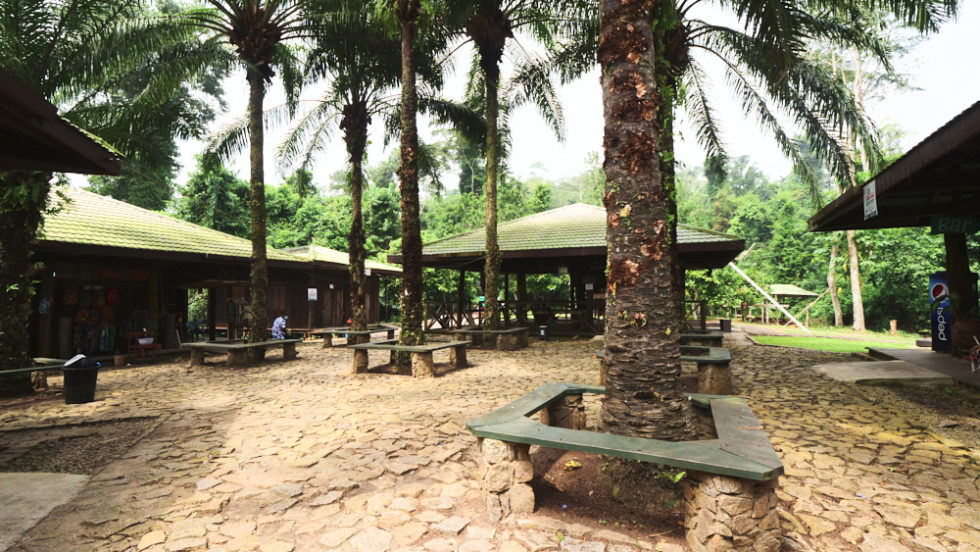
Roughly a 30-minute drive north from Cape Coast is another popular tourist attraction in Ghana, Kakum National Park. The park covers roughly 145 square miles and is home to a wide variety of wildlife, including some endangered species. If you’re lucky, you may spot an elephant or monkey there, as well as a number of birds.

This lush park is located in a thick, vibrant tropical forest. While there are two activities—a canopy walk and a nature walk—keep in mind that visitors aren’t allowed to explore on their own. You must hire a guide to accompany you. Luckily, the cost of admission is low at only 2 Cedi/$0.33 USD per person.
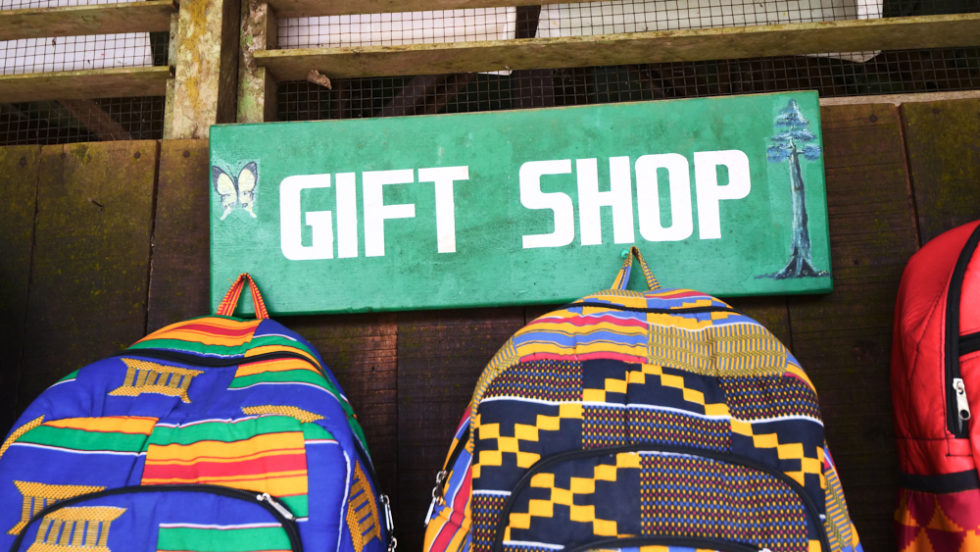
If you’d like to take your time and really spend some quality time at the park, there are a hotel and a restaurant. As one of Ghana’s top tourist attractions, it should come as no surprise that you’ll also find a gift shop. But the main attraction for me (and most other travelers) is the canopy walk.

To get to the canopy walk, you’ll have to trek uphill along a stone path that cuts through the forest. The incline is steep enough that I suggest being in reasonably good shape before attempting it. I’m pretty fit but it was tiring even for me!

The canopy walk consists of seven rope-and-metal suspension bridges among the treetops. Built in 1994, the bridges connect seven wooden platforms and take you in a big loop over 130 feet above the ground. The bridges sway ominously when you walk across them, but that’s natural. They’re actually perfectly safe!

As you cross the bridges, be sure to admire the incredible vistas of the surrounding forest. It’s absolutely gorgeous. It reminded me of a zip-lining adventure I went on in Hawaii, and other visits I’ve made to tropical forests in Malawi and Puerto Rico.

Between the amazing vistas and the experience, Kakum National Park is most definitely worth a day trips history for the next time you’re in Elmina and Cape Coast, Ghana!

Along the route between Cape Coast and Kakum National Park is Tourist Spot Restaurant. This local eatery offers a number of distinctly West African dishes and drinks, including fufu, akpeteshie, antelope, emote, grasscutter, and more.
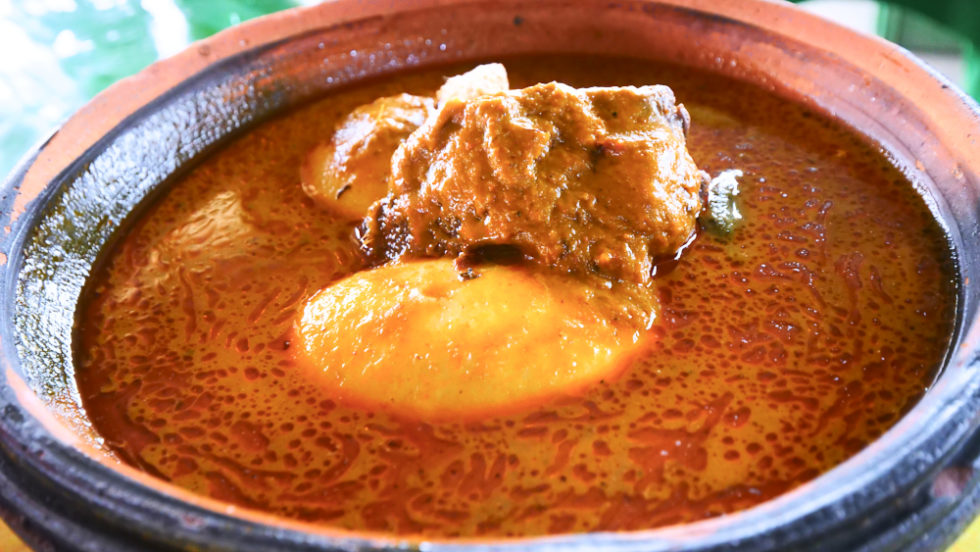
I wanted to try something a bit more adventurous, so I dove into a bowl of peanut soup with emotuo (a sticky, glutinous ball of pounded rice dough) and antelope meat. The antelope was fatty and quite tasty, and had a bit of the “wild” gamy flavor you often get in bushmeat. The rib meat was the best, as it gets a lot of flavor from the bones.

The emotuo reminded me a lot of the sticky rice I ate in Japan. I’m a sucker for peanut soups and peanut sauces, which I’ve eaten everywhere from Malaysia to Suriname. The distinct, nutty flavor is always a winner and it paired so well with the sticky rice ball and the antelope meat. It’s good enough to drink by itself!

My guide Isaac ordered his emotuo and peanut soup with grasscutter and let me try a bit of it. It was actually pretty good! Like the antelope, it was gamy, but flavor-wise, I enjoyed it. Definitely give it a try the next time you’re in the Elmina and Cape Coast region of Ghana.

Finally, you can wash it all down with some akpeteshie, a strong spirit made from distilled palm wine or cane sugar. It has a bitter, medicinal flavor, so it’s definitely an acquired taste!

Best of all, Tourist Spot Restaurant is perfect for budget travelers. I paid for three bowls and three drinks and it all came to less than $2 USD. It’s hard to beat that!

If you want to have a luxurious hotel experience in Elmina and Cape Coast, Ghana, the Golden Hill Parker Hotel is where you should stay. This cute, boutique hotel in Elmina first came about when its owners bought two dozen plots of land in the Bantuma Hills in 2012. By 2017, their 16-room luxury hotel, complete with an outdoor pool, a restaurant, and even a reflexologist opened to the public. In 2020, they were named the top hotel in central Ghana by Travel Myth!

Their rooms come in three different styles: Deluxe with a king-sized bed, Deluxe with two beds, and Superior. All of the rooms offer air conditioning, WiFi, satellite TV, blackout curtains, a mini-bar, a private safe, an intercom, and a interest private terrace.
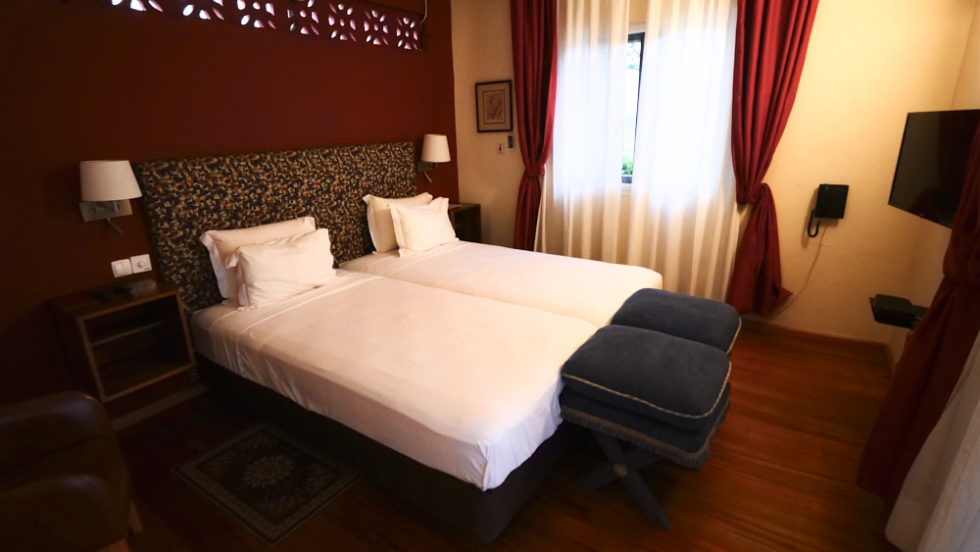
The Superior provides guests with a more luxurious bath experience with slippers and robes. Room prices range from as low as $100/night for single occupants to $130/night for two occupants for the Superior. The prices include breakfast!
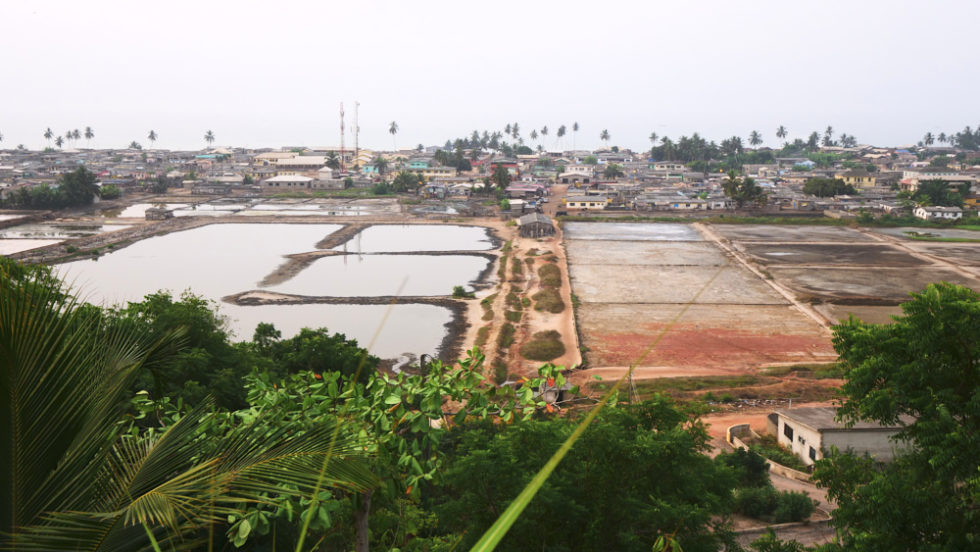
The terraces give guests beautiful views over the nearby salt flats and the city beyond. The rooms really are a slice of opulence in Elmina!

While I usually prefer eating at local restaurants when I travel, Golden Hill Parker Hotel’s Ocean View Restaurant is on another level. Led by Chef Kirk, the team there delivers a mouthwatering mix of traditional and modern Ghanaian dishes made with fresh, local ingredients.

After trying some strong akpeteshie, I watched the cooks prepare prawn curry with vegetables, prawns with jollof, yam fries, banku (fermented corn and cassava dough), okra stew with crab and fish, shito, and a salad. The yam fries with the spicy shito were great, and the prawn curry was reminiscent of a Thai green curry.

I’m a big prawns guy, so the fried prawns were a highlight for me. I also really enjoyed the yellow jollof rice with raisins.
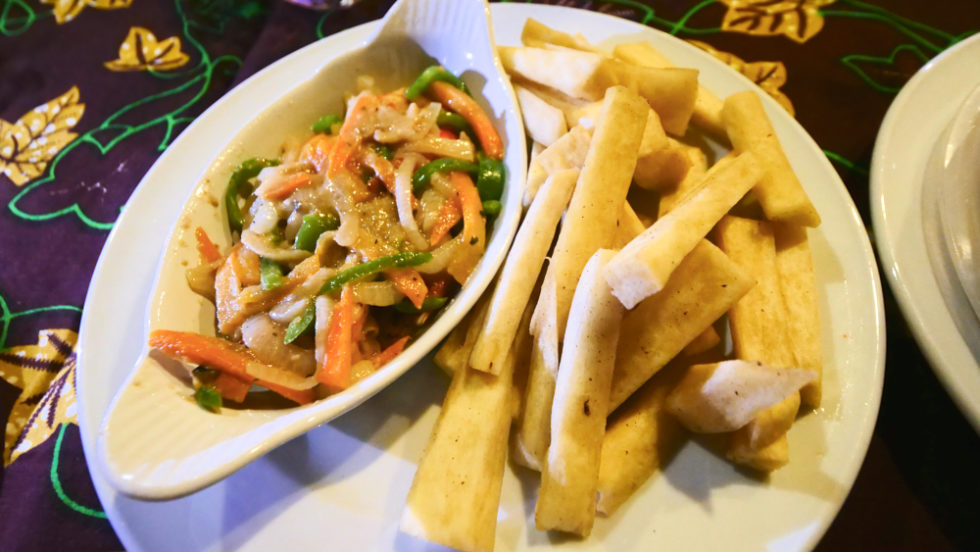
But the star of the show was the okra stew with banku, crab, and fish. The stew itself is thick and viscous because of the okra. You eat it by pinching off a bit of banku and dipping it into the stew.
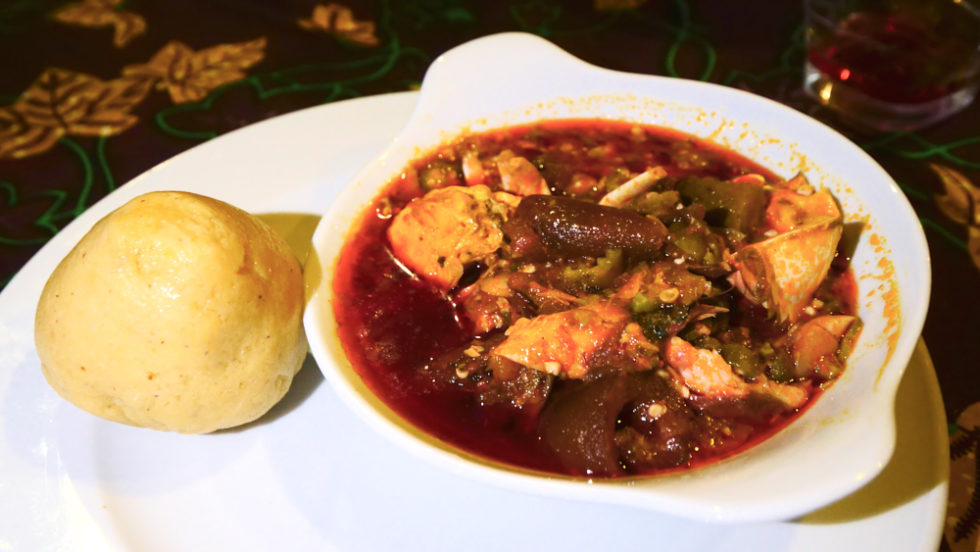
When you combine it with the briny fish and succulent crab, it’s a full flavor explosion in your mouth! Nothing on the menu is bland and the flavors will have your taste buds doing somersaults! Just be careful, as the fish contains small bones.

Pick through the fish well and use your tongue to feel around before you swallow anything and you should be good. It’s a small amount of trouble for a truly outstanding meal! If you ever visit Elmina and Cape Coast in Ghana, it’s a must!
Golden Hill Parker Hotel
3JPQ+5C5
Elmina, Ghana
+233 50 018 4040

In the area north of Elmina and Cape-Coast, Ghana and Kakum National Park are a number of small villages. If you have the time, I recommend stopping by a few with your guide. It’s a great way to get a taste of local life!
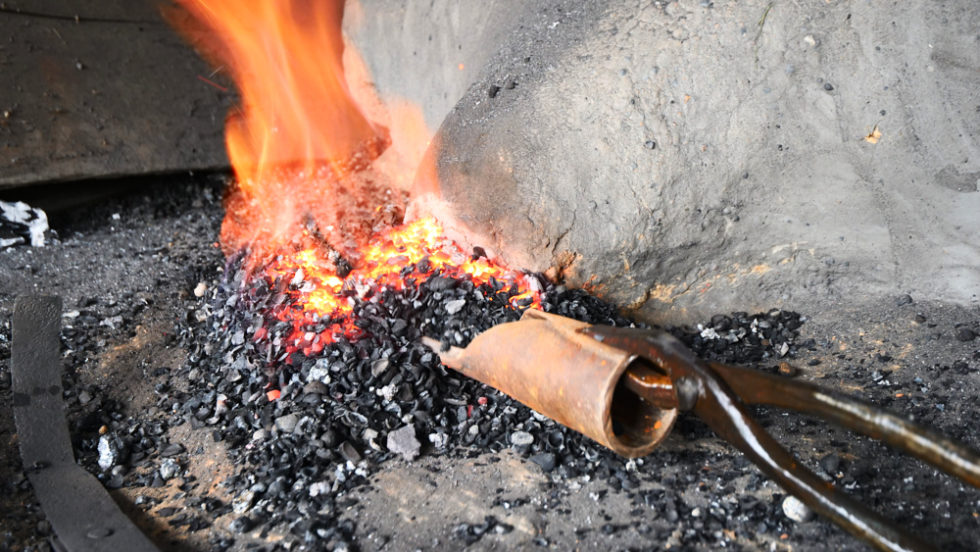
In one village, I came across a blacksmith’s shop in a makeshift structure made from bamboo and a tin room. The blacksmith was hard at work, making and sharpening farming tools by heating the metal and pounding it with a mallet. I’ve seen blacksmiths work before but it never ceases to amaze me how precise their work is!

Elsewhere, in a village closer to the cities, Isaac and I met locals roasting cassava flour in big, square pans. I had loved the cassava flour I’d tried in a number of dishes, as it added a nice crunch. The people there were very friendly and let me try some straight out of the pan. It was a wonderful glimpse into local life in Ghana!

Elmina and Cape-Coast, Ghana are beautiful seaside cities with tragic histories. But what struck me the most about them is that the people are moving forward. They refuse to be defined by the horrors that happened there just a few hundred years ago. Between my quests to learn more about the history and sample the local cuisine, I found lots of smiling faces, open hearts, and friendly and generous souls. Everywhere I’ve visited around the world, the people are always the highlight, and Elmina and Cape Coast are no different. Book a trip to Ghana today to experience it for yourself!
NOTE: If you need to check the visa requirements of a particular country, click here. To apply for a visa, find up-to-date visa information for different countries, and calculate the cost of a particular visa, click here!
Counter
101 Countries • 1432 Cities